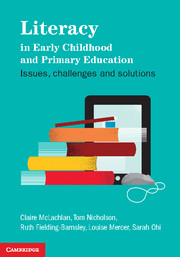Book contents
- Frontmatter
- Contents
- List of figures
- List of tables
- About the authors
- Acknowledgements
- Chapter 1 Introduction
- Part 1 Literacy acquisition: the child, the family and diversity in the modern world
- Chapter 2 Literacy acquisition in the early years: past, present and future
- Chapter 3 When should children start literacy learning?
- Chapter 4 Family literacies and relationships with centres and schools
- Chapter 5 Multiliteracies: growing the next generation of readers
- Chapter 6 Diverse classrooms and learning in bilingual and multicultural/multilingual settings
- Part 2 Learning about literacy in early childhood settings
- Part 3 Literacy learning in the primary school
- Part 4 Literacy learning in the senior primary school
- References
- Index
Chapter 6 - Diverse classrooms and learning in bilingual and multicultural/multilingual settings
from Part 1 - Literacy acquisition: the child, the family and diversity in the modern world
- Frontmatter
- Contents
- List of figures
- List of tables
- About the authors
- Acknowledgements
- Chapter 1 Introduction
- Part 1 Literacy acquisition: the child, the family and diversity in the modern world
- Chapter 2 Literacy acquisition in the early years: past, present and future
- Chapter 3 When should children start literacy learning?
- Chapter 4 Family literacies and relationships with centres and schools
- Chapter 5 Multiliteracies: growing the next generation of readers
- Chapter 6 Diverse classrooms and learning in bilingual and multicultural/multilingual settings
- Part 2 Learning about literacy in early childhood settings
- Part 3 Literacy learning in the primary school
- Part 4 Literacy learning in the senior primary school
- References
- Index
Summary
Chapter objectives
To understand how and why children learn differently.
To examine how literacy can be promoted in multicultural contexts.
To examine the issues that bilingual or multilingual children face in becoming literate.
To explore how to provide differentiated instruction for diverse learners.
Catering for diversity in classrooms is the focus of this chapter. It leads into the notion of what it means to have a negotiated curriculum where learners make choices about what they value when it comes to reading. This chapter looks at incorporating a variety of perspectives that acknowledge the variety of interests and experiences learners have to contribute to a curriculum. It also examines some of the recent research on children’s literacy acquisition in bilingual, multicultural and multilingual settings. Research on the literacy outcomes of mainstream, bilingual and total immersion settings is explored, along with the barriers to literacy acquisition that bilingualism and multilingualism have been found to create in many countries. Further, research on Indigenous Australians in early years and primary settings is examined and the implications for educational practice identified.
- Type
- Chapter
- Information
- Literacy in Early Childhood and Primary EducationIssues, Challenges, Solutions, pp. 82 - 98Publisher: Cambridge University PressPrint publication year: 2012

